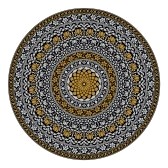 |
American Literature: Romanticism research assignment Student Research Submissions 2013 research post 2 |
 |
Matthew Martin
3 May 2013
Beyond the Hudson: Popularity and Changes of Landscape Art
From the years 1825 to 1860, the artists who comprised the Hudson River School
(HRS) flourished by creating works of "religious, moral, and aesthetic themes"
in the spectrum of landscape paintings (Cooper 15). In my first research post, I explored the impact of the Hudson River School artists on other
areas of art, namely literature. I learned that the artists were most likely
influenced by the writings of pertinent authors of the period such as Emerson,
Thoreau, and James Fenimore Cooper (HRS artist Thomas Cole painted the
illustrations of Cooper's seminal The Last of the Mohicans), thus showing
a connection between the artists and their literary counterparts. While it was a
worthwhile focus of research and filled with aesthetically pleasing landscapes,
it proved to be as challenging to research as it was fulfilling. The Hudson
River School of artists represented merely a small thread in the fabric of
American art during the Romantic era. Prior to our midterm, the literary texts
we discussed in class were closely tied to artists from the HRS (works by
Irving, Thoreau and Cooper). Nature was a prominent feature in each author's
narrative. As we continued to move forward in the era, I noticed nature becoming
less and less prominent in each work. Nature became replaced by realism,
societal progress and westward expansion. Disappearing in the texts were the
picturesque landscapes Thomas Cole, Asher Brown Durand, and Frederic Edwin Church
immortalized on canvas. The physical and moral landscape of America was
changing. Authors were focusing on the human being in society and not in nature.
Since our texts were changing, I was interested in why landscape painting was
still such a popular form of expression in a time period that was experiencing
great technological and industrial changes.
Part of the reason landscape scenes remained popular is because of artists like
Thomas Cole ushering in their appeal to a mass audience. Since nature inspired
such scenes of artistic beauty, it was not long before the general public
attempted to experience such inspiration for themselves. Tourists started to
take advantage of resorts built in the area where Cole created some of his most
memorable works. In his article, “The Parlor in the Wilderness . . . ,” Harvey K.
Flad describes the growth in popularity of “nature focused” hotels and tourist
resorts that began to be built in the Catskill mountains. To Flad, this was a
double-edged sword. Nature was accessible to those who wished to observe it, but
its majesty was diluted. One such resort was the Catskill Mountain House which
offered accessibility to nature, while still offering comfortable resort
amenities. "Following the lead of famous artists . . . lesser painters and poets
flocked to the same places to be inspired with the gifts of nature . . . . By 1880,
70,000 visitors were making the trip each summer to Catskill Mountain resorts
and boarding-houses to enjoy luxurious accommodations or a homelike atmosphere
in a wilderness setting" (Flad 361). The beauty of nature was accessible to
those who wished to make the trip to the resort, but its grandeur and
frightening power was diminished because of modernity cutting into the
wilderness. "The landscape [visitors] found, however, was not wilderness.
Prospects from which to safely view the surrounding landscape were located,
constructed, and often framed. Artists and writers sanctified many of the
scenes; they were duly noted in guidebooks and on trail maps" (361).
The popularity of resorts, plus the diminishing size of nature due to civilization expansion, may have made nature a staple of many artists' works, but the grandeur was fleeting as quickly as its size. Author Robert Chianese argues that "the persistent commercial exploitation and destruction of American land and its native inhabitants . . . led . . . painters to avoid the sublime. In the Hudson Valley, preservationist programs diminished the natural world to a fragile aesthetic commodity that had to be protected rather than feared" (437). Resorts and tourist destinations were slowly fueling the view of nature strictly as a system existing for our control instead of vice versa. As the landscape was disappearing to make way for a growing society, art was losing its ability to show nature as a terror and awe invoking entity. As Chianese states, "Elements of the natural world-- . . . the ocean, a bull or wolf--must threaten in order to evoke the sublime; a prairie cannot, because while vast, it does not instill terror, a horse cannot, nor anything we control or use...'Nature' must have agency and contend with us in a battle of wills" (437). Because the country was growing and able to control nature, Artists would still maintain nature as a prominent subject in years following the HRS and the ever-expanding American scope into the unknown that would more or less become tamed by the hands of man.
As the country experienced great changes (both positive and negative), the
outlook of the landscape was changing in the eyes of the artists. The changes
were reflected on their canvases. The years following the Civil War gave way to
another movement of American landscape artists: Tonalism.
While the HRS artists immortalized nature in its glory and terror, landscape
painting retained its popularity into the twentieth century (though it waned
when newer, cutting-edge artwork began dominating artistic circles) and
represented much more than what was shown on the canvas. It reflected the
diminishing size and understatement society had on nature itself, and with
movements like Tonalism, showed a country that may have been expanding but was
also reeling from its own losses and moral decay. Landscape painting had a life
beyond the HRS, one that had surprising results and meaning. I found the
research for this particular post smoother than my previous post, which I expect
is the result of broadening my research question to explore different aspects of
the landscape art movement rather than focusing on the works a particular group
of artists.
Works Cited
Chianese, Robert. "Avoidance of the Sublime in Nineteenth-Century American
Landscape Art: An Environmental Reading of Depicted Land."
Amerikastudien/American Studies 43.3 (1998): 437-61. JSTOR. Web. 3
May 2013.
Cleveland, David A. A History of American Tonalism: 1880-1920. New York:
Hudson Hills, 2010. Print.
Cooper, James F. Knights of the Brush: The Hudson River School and the Moral
Landscape. New York: Hudson Hills, 1999. Print.
Flad, Harvey K. "The Parlor in the Wilderness: Domesticating An Iconic American
Landscape." Geographical Review 99.3 (July, 2009): 356-76. Academic
Search Complete. Web. 3 May 2013.
Moss, Maria. "Introduction: Two Centuries of the Sublime in American Landscape,
Art, and Literature." Amerikastudien/American Studies 43.3 (1998):
389-90. JSTOR. Web. 3 May 2013.
|
|
|
|


